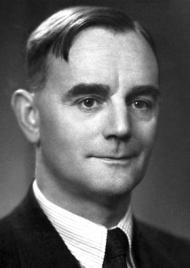Cecil Frank Powell (5 December 1903 – 9 August 1969) was a British physicist, and Nobel Prize in Physics laureate for his development of the photographic method of studying nuclear processes and for the resulting discovery of the pion (pi-meson), a subatomic particle.
Powell was born in Tonbridge, Kent, England, the son of a local gunsmith, and educated at a local elementary school before gaining a scholarship to the Judd School, Tonbridge, which now has one of its four houses named after Powell (the house colour is green), and awards the Powell Physics and Mathematics Prize to an upper sixth form student every year in his honour. Following this he attended Sidney Sussex College, Cambridge, graduating in 1925 in the natural sciences. After completing his bachelor's degree he worked at the Cavendish Laboratory, Cambridge, under C.T.R. Wilson and Lord Rutherford, conducting research into condensation phenomena, and gaining his Ph.D. in Physics in 1927.
In 1928 he took up a post as Research Assistant to A.M. Tyndall in the H.H. Wills Physical Laboratory at the University of Bristol, later being appointed lecturer, and in 1948 appointed Melville Wills Professor of Physics. In 1932 Powell married Isobel Artner, and the couple had two daughters. In 1936 he took part in an expedition to the West Indies as part of a study of volcanic activity, and where he appears on a stamp issued in Grenada.
During his time at Bristol University Powell applied himself to the development of techniques for measuring the mobility of positive ions, to establishing the nature of the ions in common gases, and to the construction and use of a Cockcroft generator to study the scattering of atomic nuclei. He also began to develop methods employing specialised photographic emulsions to facilitate the recording of the tracks of elementary particles, and in 1938 began applying this technique to the study of cosmic radiation, exposing photographic plates at high-altitude, at the tops of mountains and using specially designed balloons, collaborating in the study with Giuseppe Occhialini, H. Muirhead and young Brazilian physicist César Lattes. This work led in 1946 to the discovery of the pion (pi-meson), which proved to be the hypothetical particle proposed in 1935 by Yukawa Hideki in his theory of nuclear physics.
In 1949 Powell became a Fellow of the Royal Society and received the society's Hughes Medal the same year. In 1950 he was awarded the Nobel Prize for Physics "for his development of the photographic method of studying nuclear processes and his discoveries regarding mesons made with this method". From 1952 Powell was appointed director of several expeditions to Sardinia and the Po Valley, Italy, utilizing high-altitude balloon flights.
In 1955, Powell, also a member of the World Federation of Scientific Workers, added his signature to the Russell-Einstein Manifesto put forward by Bertrand Russell, Albert Einstein and scientist Joseph Rotblat, and was involved in preparations for the first Pugwash Conference on Science and World Affairs. As Rotblat put it, "Cecil Powell has been the backbone of the Pugwash Movement. He gave it coherence, endurance and vitality." Powell chaired the meetings of the Pugwash Continuing Committee, often standing in for Bertrand Russell, and attended meetings until 1968.
In 1961 Powell received the Royal Medal, and served on the Scientific Policy Committee of the European Organization for Nuclear Research (CERN) that year, and in 1967 he was awarded the Lomonosov Gold Medal by the Academy of Sciences of the USSR (now Russian Academy of Sciences) "for outstanding achievements in the physics of elementary particles".
Powell died on 9 August 1969, whilst out walking in the foothills of the Alps near the Valsassina region of Italy, where he had been staying with friends. A bench with commemorative plaque was erected near the site of his death and dedicated to his memory.

